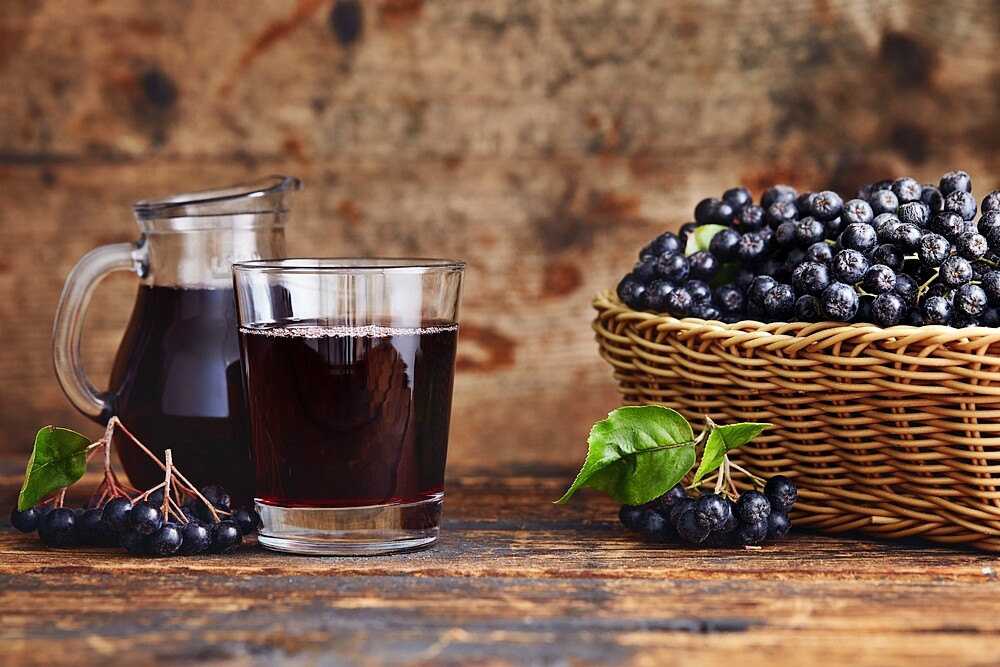Aronia is considered a healthy superfood berry with many advantages. But there are also downsides. You can find out what’s behind it here.
Aronia: Origin
- Aronia berries are also called black chokeberries. They belong to the rose family and originate from North America.
- The berries have a purple-black colour and are about the size of a pea. For more than 100 years now, the berry has also been common in Europe. The plants grow in flat regions as well as in mountains. The warmer the location, the more fruit sweetness there is in the berries.
- Aronia berries are often advertised as so-called superfood, as they contain many vitamins and plant substances. You can read all about their effects in this article.
Taste of Aronia
Aronia berries contain a finely tart and sour taste. And this is completely independent of whether you consume them fresh or processed. Even when diluted with water, the colour remains purple-red. Natural plant dyes ensure this.
Ingredients
- Iodine
- Iron
- Folic acid
- Provitamin A
- Vitamin B2
- Vitamin C
- Vitamin K
- Flavonoids
- Phenolic acids
Aronia: How healthy are they?
- Aronia berries contain many secondary plant substances. Due to the antioxidants present, they can fight free radicals in the body. These free radicals have a negative effect on cell metabolism and accelerate the ageing process.
- Due to the large number of vitamins, the berries can strengthen the immune system and prevent diseases. A positive effect or prevention of diseases such as cancer, which is often reported in the media, cannot be scientifically proven.
- Watch it: Aronia supplements often contain artificially added vitamins. Often the exact composition of the ingredients cannot be traced.
Use of aronia
- Although chokeberries contain relatively high levels of fructose, they still have a sour-tart taste. This is why most consumers prefer chokeberry juice or chokeberry jam.
- Aronia berries are also often offered as delicious dried fruits that go perfectly with muesli. They are also used as a colouring agent for sweets. There are also various food supplements that contain chokeberry as an ingredient, at least in part.
- Take care to dilute the aronia juice with water so that the taste is not so tart and stomach problems can also be avoided. However, you can also use the fresh berries to enhance muesli, yoghurt or ice cream.
Aronia: Is the consumption harmful?
- Aronia berries contain small amounts of amygdalin, which can release prussic acid in the body. Amygdalin is a toxic plant substance. It contains glycoside, which is split into almond acid nitrile glucoside in combination with water. In combination with other enzymes, this in turn decomposes into prussic acid.
- Prussic acid can lead to symptoms such as shortness of breath, cramps or enlarged pupils. In very serious cases, a blockage in the respiratory chain can even cause death.
- Does this mean you can’t eat aronia berries? No, don’t worry. You should only consume fresh fruit in small quantities. According to studies, processed products are not harmful even if consumed regularly.
- As a general rule, you should also prefer organic products in order to avoid potentially existing pesticide residues or contamination with heavy metals, which is always the case with products from distant countries.
You’re a fan of superfoods? Then take a look at our article on the acai berry.


Editors:
I was doing some research on aronia and this article came up.
It seems that this article would benefit from review, research, and being rewritten using modern data. It can be much better and helpful to your readers.
It appears that at the time this was written, the writer had no significant experiences with aronia berries. The article contains dated, incorrect, and medically inaccurate assertions, which are unhelpful to the reader.
As a small example, aronia berries are somewhat bigger than a pea, and do not grow well in a very warm environment that does not have a significant freezing weather season cycle. That is why the growth of aronia has notably increased in Iowa, South Dakota, Minnesota, Wisconsin, and North Dakota, and also why they can be grown in Poland and in Siberia. The tartness/dryness/astringency is well known, and appreciated by many in dry red wines and other drinks and foods.
The section describing use of aronia is very generic and limited; many people drink pure aronia juice daily as a health support drink (like 2-4 oz daily). Aronia is used in in pies, cakes, crisps, smoothies, wines, meads, sauces, and as part of main dishes. The traditional use of chokeberry in Native American cooking is well known.
Also, the entire last section is unsupported by current medical research and findings in the last 5 years or more. Consider searching aronia on PubMed (https://pubmed.ncbi.nlm.nih.gov/) for research and current scientific thought.
The current online environment seems to be generally adverse to responsive commentary, but I hope this is helpful, since it is helpful to all of us to have great online resources. Your site looks to have a lot of overall helpful info.
Thank you and best wishes.
JNR